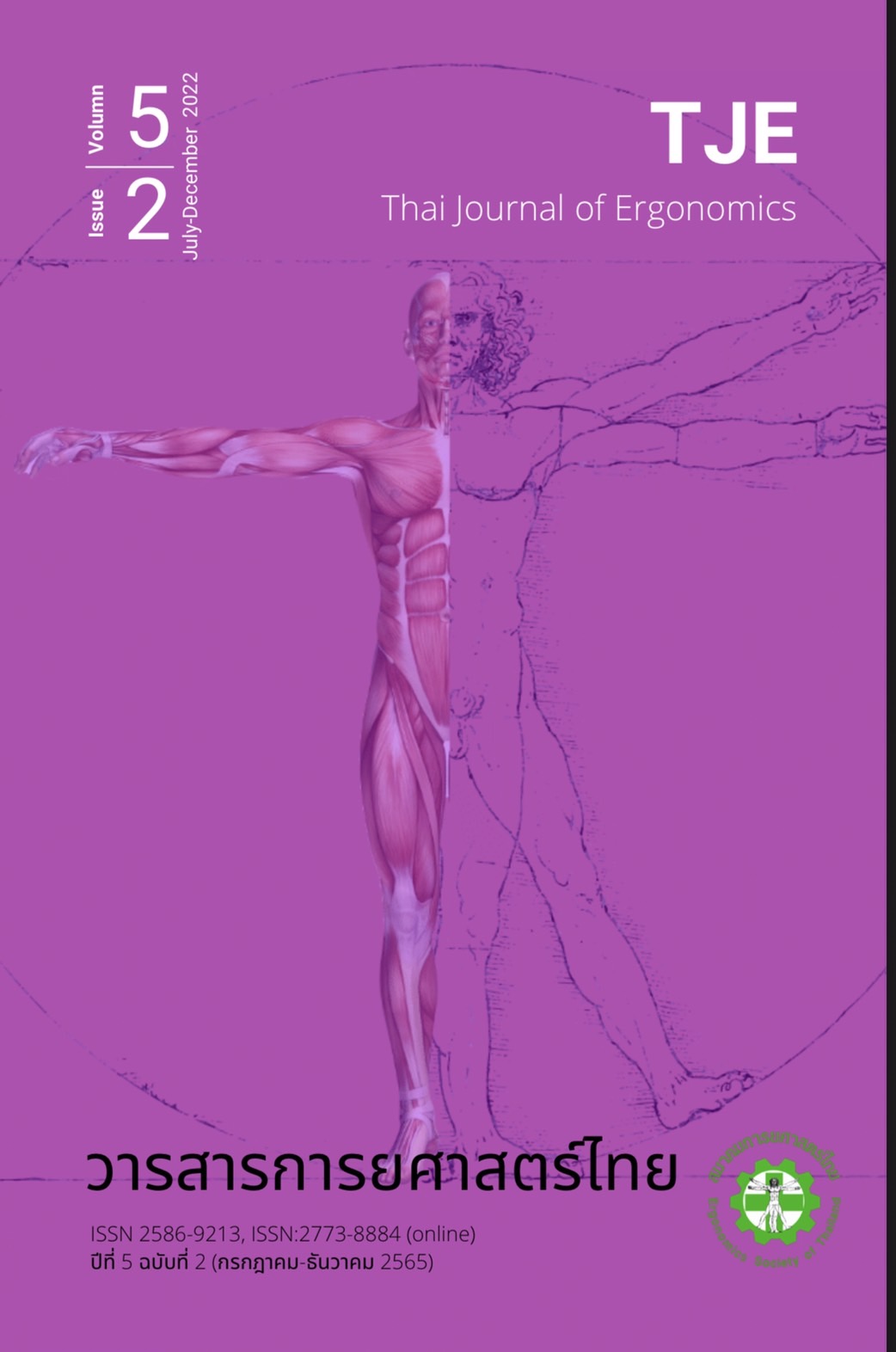The effectiveness of improvement of kitchen turner handle for reducing the risk of shoulder and low back muscle in stir-frying task among cooks at nutrition unit in a hospital
Main Article Content
Abstract
The use of the kitchen turner with the improper handle length and grip position in a stir-frying task increases the ergonomic risk and exertion of the shoulder and lower back muscles of the cook. This research aimed to assess the effectiveness of improvement of the length of the kitchen turner handle and the grip position by applying the Pythagorean theorem. Overall, 19 stir-frying cookers from the nutrition department of a hospital who met the inclusion criteria were recruited to participate in this study. The research instruments of this study included the structured questionnaire, the Rapid Entire Body Assessment (REBA) and the electromyography (EMG). Using the improved turner handle, the results revealed that the mean REBA scores of the dominant and non-dominant shoulders were decreased significantly (p < 0.01). In the lower back assessment, the mean REBA score was also reduced significantly (p < 0.01) after the improvement. For the evaluation of muscle exertion using EMG after the improvement of the handle, it showed that the mean percentage of maximum voluntary contraction (%MVC) of the anterior deltoid muscle on the dominant side and the posterior deltoid muscles on the dominant and non-dominant sides were decreased significantly (p < 0.01). In addition, the mean of %MVC of Erector spinae muscles of both dominant and non-dominant sides and Latissimus dorsi muscles of both dominant and non-dominant sides was decreased significantly (p < 0.01). The results from this study showed the applying Pythagorean theorem for the length of the kitchen turner handle and the grip position could reduce the ergonomic risk on the shoulder and lower back muscles. Therefore, it may be used as a basis for further development of handle designs in other devices.
Article Details

This work is licensed under a Creative Commons Attribution-NonCommercial-NoDerivatives 4.0 International License.
References
ธวัชชัย รักษานนท์ และคณะ. แนวทางการจัดบริการอาชีวอนามัยให้กับแรงงานในชุมชนด้านการยศาสตร์ สำหรับเจ้าหน้าที่หน่วยบริการสุขภาพปฐมภูมิ. นนทบุรี: สำนักโรคจากการประกอบอาชีพและสิ่งแวดล้อม กรมควบคุมโรค; 2560.
กองโรคจากการประกอบอาชีพและสิ่งแวดล้อม. รายงานสถานการณ์ โรคและภัยสุขภาพจากการประกอบอาชีพและสิ่งแวดล้อมปี 2561. นนทบุรี: กองโรคจากการประกอบอาชีพและสิ่งแวดล้อม กรมควบคุมโรค; 2561.
Xu YW, Cheng AS, Li-Tsang CW. Prevalence and risk factors of work-related musculoskeletal disorders in the catering industry: A systematic review. Work. 2013;44(2):107-16.
Survey on occupational safety and health conditions of kitchen work in chinese restaurants [Internet]. Occupational Safety and Health Council. 2000 [cited 2021 April 25]. Available from: https://www.oshc.org.hk/oshc_data/files/OSHInformation/e_kitchen_work.pdf.
Chyuan JYA, Du CL, Yeh WY, Li CY. Musculoskeletal disorders in hotel restaurant workers. Occup Med. 2004;54(1):55-7.
Wu SP, Ho CP, Yen CL. The effect of wok size and handle angle on the maximum acceptable weights of wok flipping by male cooks. Ind Health. 2011;49(6):755-64.
Sulaiman R, Taha Z, Dawal SZM. Application of anthropometric dimensions for estimating stove height, stove depth and cooking task envelope for Malaysian elderly population. Pertanika J Sci & Technol. 2013;21(1):15-28.
รุ้งเพชร แสงจันทร์. ความผิดปกติทางระบบกระดูกและกล้ามเนื้อที่เกี่ยวข้องกับการทำงานในฝ่ายโภชนาการ โรงพยาบาลพระนั่งเกล้า. วารสารเทคนิคการแพทย์และกายภาพบำบัด. 2559;28(3):322-8.
อติรัฐ มากสุวรรณ์. หลักการและค่าการได้เปรียบเชิงกลของเครื่องกลสามัญและเครื่องกลเชิงซ้อนสาหรับเครื่องผ่อนแรงทางการเกษตร. วารสารวิชาการสถาบันการอาชีวศึกษาเกษตร. 2563;4(1):1-19.
Shete K, Pandve H, Puntambekar T. Role of ergonomics in kitchen related back problems. Journal of Ergonomics. 2015;5(3) doi: 10.4172/2165-7556.1000e141
Ergonomics Standard [Internet]. 2019 [cited 2021 June 18]. Available from: https://public.cummins.com/sites/CSP/SiteCollectionDocuments/StandardsandProcesses/CORP-09-10-03-01%20Ergonomics%20Standard.pdf.
Drake RL, Vogl W, Mitchell AWM, Gray H. Gray's anatomy for students. 4th ed. Philadelphia: Elsevier; 2020.
Rempel D, Bach JM, Gordon L, So Y. Effects of forearm pronation/supination on carpal tunnel pressure. J Hand Surg Am. 1998;23(1):38-42.
ณัฐ ปั้นเปล่ง และคณะ. การประเมินความเสี่ยงด้านการยศาสตร์ในงานผัดอาหารของพนักงานแผนกโภชนาการในโรงพยาบาลแห่งหนึ่งในจังหวัดชลบุรี. การประชุมวิชาการะดับชาติและนานาชาติ "ราชภัฎสุราษฎร์ธานีวิจัย ครั้งที่ 17". 2565:631-41.
Chow SC, Shao J, Wang H, Lokhnygina Y. Sample size calculations in clinical research. New York: Chapman and Hall/CRC; 2017.
Hignett S, McAtamney L. Rapid entire body assessment (REBA). Appl Ergon. 2000;31(2):201-5.
ปวีณา มีประดิษฐ์. การประเมินความเสี่ยงทางด้านการยศาสตร์ กรุงเทพฯ: โอ. เอส. พริ้นติ้ง เฮาส์; 2559.
Openshaw S, Taylor E. Ergonomics and design: a reference guide. DIANE Publishing Company; 2006.
กระทรวงอุตสาหกรรม. มาตรฐานผลิตภัณฑ์อุตสาหกรรม การวัดสัดส่วนร่างกายพื้นฐานสำหรับการออกแบบเชิงเทคโนโลยี เล่ม1: บทนิยามและตำแหน่งการวัดสัดส่วนร่างกาย. กระทรวงอุตสาหกรรม; 2553.
McDonald AC, Calvin T, Keir PJ. Adaptations to isolated shoulder fatigue during simulated repetitive work. Part II: Recovery. J Electromyogr Kinesiol. 2016;29:42-9.
Shin HJ, Kim JY. Measurement of trunk muscle fatigue during dynamic lifting and lowering as recovery time changes. Int J Ind Ergon. 2007;37(6):545-51.
Ekpenyong CE, Inyang UC. Associations between worker characteristics, workplace factors, and work-related musculoskeletal disorders: a cross-sectional study of male construction workers in Nigeria. Int J Occup Saf Ergon. 2014;20(3):447-62.
Subramaniam S, Murugesan S. Investigation of work-related musculoskeletal disorders among male kitchen workers in South India. Int J Occup Saf Ergon. 2015;21(4):524-31.
Park J, Kim Y, Han B. Work sectors with high risk for work-related musculoskeletal disorders in Korean men and women. Saf Health Work. 2018;9(1):75-8.
Choi SD, Brings K. Work-related musculoskeletal risks associated with nurses and nursing assistants handling overweight and obese patients: a literature review. Work. 2016;53(2):439-48.
Anthropometry and Workspace Design [Internet]. 2013 [cited 2021 February 23]. Available from: https://ergo.human.cornell.edu/studentdownloads/DEA3250pdfs/AnthroDesign.pdf.
Berlin C, Adams C. Production ergonomics: designing work systems to support optimal human performance. London: Ubiquity Press; 2017. p. 65-82.
Wu SP, Hsieh CS. Ergonomics study on the handle length and lift angle for the culinary spatula. Appl Ergon. 2002;33(5):493-501.
Final report on the study of work-related musculoskeletal disorders in catering industry in Hong Kong [Internet]. 2011 [cited 2021 April 20]. Available from: https://www.oshc.org.hk/oshc_data/files/OSHInformation/Musculoskeletal%20Disorders_Catering_Eng.pdf.
Wallius MA, Rissanen SM, Bragge T, Vartiainen P, Karjalainen PA, Räsänen K, et al. Effects of mop handle height on shoulder muscle activity and perceived exertion during floor mopping using a figure eight method. Ind health. 2016;54(1):58-67.
Imrhan SN, Farahmand K. Male torque strength in simulated oil rig tasks: the effects of grease-smeared gloves and handle length, diameter and orientation. Appl Ergon. 1999;30(5):455-62.
Shoulder muscles [Internet]. 2021 [cited 2021 April 16]. Available from: https://www.kenhub.com/en/library/anatomy/shoulder-muscles.
Raschke U, Chaffin DB. Support for a linear length-tension relation of the torso extensor muscles: an investigation of the length and velocity EMG-force relationships. J Biomech. 1996;29(12):1597-604.
Roy AL, Keller TS, Colloca CJ. Posture-dependent trunk extensor EMG activity during maximum isometrics exertions in normal male and female subjects. J Electromyogr Kinesiol. 2003;13(5):469-76.


